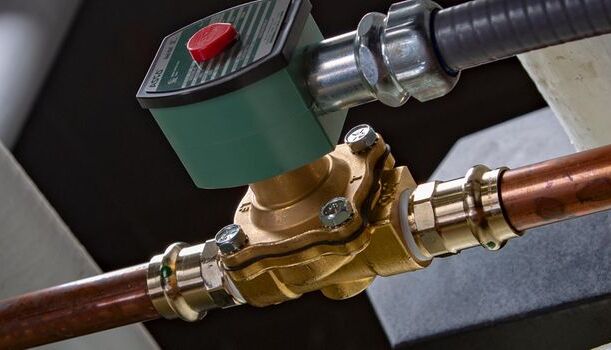Solenoid valves are electro-mechanical control units used to control the flow of a medium. When choosing a solenoid valve in the market, there are certain factors you always want to consider. We’ve rounded up some of these factors below to help you pick the proper solenoid valve for your unique applications.
IMAGE: UNSPLASH
Solenoid Valve Selection Criteria
Here are the key aspects to consider when choosing a solenoid valve.
1. Operating Principle
There are three operating types of solenoid valves: direct operated, semi-direct operated, and indirect operated. Direct-operated types work from zero bar and are often used in operations with small flow rates.
Semi-direct operated valves also work from zero bar, while the indirect type requires some pressure differential of at least 0.5 bar. Semi-direct and indirect are typically used for larger flow rates as they use medium pressure to assist in closing and opening the valve.
The semi-direct valves have a more powerful coil than the indirect-operated valves. However, indirect-operated solenoid valves can control large fluid flows using a relatively small coil but require a permanent pressure differential for optimal operation. The benefit of using the indirect operated valves for larger flow rates is the reduced energy consumption due to the smaller coil.
You should pick either an indirect-operated or semi-direct valve for applications with a permanent pressure differential of at least 0.5 bar over the valve. However, if there’s no pressure differential, for instance, in a closed circuit with low inlet pressure, pick a direct or semi-direct operated solenoid valve.
2. Valve Sizing
The size of the valve refers to its flow rate or capacity. This is further determined by the orifice diameter and the shape of the valve body. The valve’s flow factor (Kv) measures the flow rate for the given pressure drop and medium. Another factor you can use to select the correct valve size intuitively is the orifice or pipe connection size. The higher the Kv-value (flow coefficient), the higher the valve’s flow rate at a given pressure.
The formulas for calculating the flow rate of different fluids such as water, gas, oil, etc., vary. By understanding the flow principles, you can easily calculate the valve sizing for various fluid mediums.
3. Thread Type, Pipe Diameter, And Fittings
Typically, solenoid valves have female threads of varying types. Common options are British Standard Pipe (BSP), National American Pipe Thread (NP), Metric Thread ISO (M), or Unified Thread Standard (UTS). Therefore, the component the solenoid valve will be connected to needs to have the same thread type, but male version. Occasionally, there are other fittings types, like push-in, push-on, hose pillar, flange, etc.
4. Medium To Be Controlled
Solenoids valves are designed to control neutral gases and liquids such as air, steam, fuels, oils, water, and lubricants. When choosing a solenoid valve, ensure that the housing and seal material is compatible with the fluid medium to be controlled.
Before picking any solenoid valve, check the chemical resistance of different materials to understand which one works best for your unique applications. For instance, brass is used for most solenoid valves, while stainless steel is used for intensive applications as it can withstand corrosive and aggressive media like seawater.
Seal materials like nylon have good chemical and mechanical properties, and since they are inexpensive, they are suitable for household and irrigation purposes. The seal material also comes with varying properties that make them ideal for a set of different applications. For instance, Viton (FKM) has good chemical resistance but isn’t suitable for hot water or steam applications.
5. Circuit Function
The two most important circuit functions that determine the valve’s purpose in a circuit are the 2/2-way and the 3/2-way configurations. The 2/2-way function means the valve has an inlet and outlet port and two positions (open and closed.) Most of these valves are normally closed (NC) types.
The 3/2-way valves have three ports and two positions. They are often direct-operated and suitable for small flow rates. 3/2-way valves can be normally open (NO), normally closed (NC), diverting, or universal types.
6. Pressure And Temperature
Every valve has a specified maximum pressure, which must not be exceeded. This maximum pressure is often associated with a given type of material used. Similarly, you want to pay attention to the minimum pressure differential, i.e., between the inlet and the outlet, often expressed in bars.
7. Voltage and Response Time
Solenoid coils can use either AC or DC currents at different voltages, which affects the valve’s characteristics. Most DC coils do not require polarity unless additional components like an LED connector or time are used. Low voltage coils offer increased electrical safety, but there must always be some limits since the current is higher at lower voltages. That said, AC coils are more powerful than their DC counterparts and may be an ideal option for heavy-duty operations.
8. Ingress Protection (IP) Rating
The IP rating of a solenoid valve determines the solenoid valve’s level of protection against water, dust, and physical access to the hazardous parts. This IP code comprises of two digits, where the first one represents the protection level against physical access to hazardous components and ingress of objects. The second digit indicates the level of protection against moisture.
Final Comments
Choosing a solenoid valve in the flooded market can be a daunting experience, especially when it’s your first time buying it. However, with the help of this guide, you’ll be in a better position to choose what’s ideal for your application.
Regardless of the solenoid valve you’ve chosen, it’s worth noting that these control units are sensitive to dirt and will only work with clean liquids or air. Similarly, the solenoid valves should only be used for their intended purpose. This is because some valve materials are only designed to handle a particular medium at specific temperatures. The opening and closing speeds also vary significantly, and improper use could cause water hammers.
IMAGE: UNSPLASH
If you are interested in even more technology-related articles and information from us here at Bit Rebels, then we have a lot to choose from.


COMMENTS